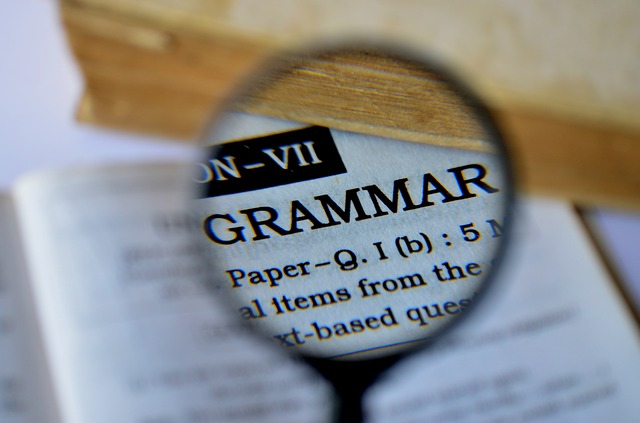Grammar Spotlight
 The English Grammar Profile (EGP) is a sister resource to the English Vocabulary Profile, and has been put together by Anne O'Keeffe (Limerick University) and Geraldine Mark, the co-authors, along with Ron Carter and Mike McCarthy, of English Grammar Today (Cambridge University Press). Mark and O'Keeffe investigated the extensive data in the Cambridge Learner Corpus to establish when learners begin to get to grips with different linguistic structures.
The English Grammar Profile (EGP) is a sister resource to the English Vocabulary Profile, and has been put together by Anne O'Keeffe (Limerick University) and Geraldine Mark, the co-authors, along with Ron Carter and Mike McCarthy, of English Grammar Today (Cambridge University Press). Mark and O'Keeffe investigated the extensive data in the Cambridge Learner Corpus to establish when learners begin to get to grips with different linguistic structures.
A series of insights from their research will be posted on this page, each one putting the spotlight on an interesting aspect of learner grammar development. Please note that all of the learner examples come from the Cambridge Learner Corpus, a 55-million word electronic collection of written learner data. The examination and the candidate’s first language are given in brackets after each learner example.
See the latest Grammar Spotlight entry below. Scroll right down to the bottom of this page to browse through previous entries.
The use of should appears in learner work only once the A2 level is achieved. Learners at this level are able to show an ability to use the affirmative form with confidence.
 You should come at 6 o’clock. (Cambridge English: Key; Russian)
You should come at 6 o’clock. (Cambridge English: Key; Russian)
 It is a new flat, so there shouldn’t be any problems. (Skills for Life: Entry 2; Polish)
It is a new flat, so there shouldn’t be any problems. (Skills for Life: Entry 2; Polish)
 We should buy 2 tickets. (Cambridge English: Key; Chinese)
We should buy 2 tickets. (Cambridge English: Key; Chinese)
Learners are also able to use the negative form. Interestingly, learners at this level show a clear preference for the contracted form (shouldn’t). This preference is the reverse with native speakers but shouldn’t is the more frequently used negative form in learner work until the B2 level is achieved.
 You shouldn’t arrive later than 2:15 pm. (Cambridge English: Key; French)
You shouldn’t arrive later than 2:15 pm. (Cambridge English: Key; French)
 It is a new flat, so there shouldn’t be any problems. (Skills for Life: Entry 2; Polish)
It is a new flat, so there shouldn’t be any problems. (Skills for Life: Entry 2; Polish)
 I think you should not wear your favourite clothes because they may get dirty. (Cambridge English: Key; Thai)
I think you should not wear your favourite clothes because they may get dirty. (Cambridge English: Key; Thai)
Learners can also use should in its interrogative form.
 Should I wear special clothes? (Cambridge English: Key; Farsi)
Should I wear special clothes? (Cambridge English: Key; Farsi)
 It’s going to be in São Paulo. Should we go by plane? (Cambridge English: Key; Portuguese)
It’s going to be in São Paulo. Should we go by plane? (Cambridge English: Key; Portuguese)
 Should I take everything that you need or will you take your tools? (Skills for Life: Entry 2; Turkish)
Should I take everything that you need or will you take your tools? (Skills for Life: Entry 2; Turkish)
Should also appears in learner work as part of wh-questions.
 What colour should I paint my room? (Cambridge English: Key; Spanish- Latin American)
What colour should I paint my room? (Cambridge English: Key; Spanish- Latin American)
 How should I pay the rent? (Skills for Life: Entry 2; Turkish)
How should I pay the rent? (Skills for Life: Entry 2; Turkish)
 What time should I get there? (Cambridge English: Key; Chinese)
What time should I get there? (Cambridge English: Key; Chinese)
A2 learners use should to give advice.
 It was only €70. It is pink. It looks very nice. My advice, you should buy this. (Cambridge English: Key; Turkish)
It was only €70. It is pink. It looks very nice. My advice, you should buy this. (Cambridge English: Key; Turkish)
 On Monday, you will have to stay in this class for six hours so you should bring something to eat because you will be hungry. (Cambridge English: Key; French)
On Monday, you will have to stay in this class for six hours so you should bring something to eat because you will be hungry. (Cambridge English: Key; French)
 You should take some money because the ticket costs £4.00. (Cambridge English: Key; Italian)
You should take some money because the ticket costs £4.00. (Cambridge English: Key; Italian)
Should is also used to make suggestions.
 I think we should meet at 2 pm, and my mother will take us there so don’t worry. (Cambridge English: Key; Spanish)
I think we should meet at 2 pm, and my mother will take us there so don’t worry. (Cambridge English: Key; Spanish)
 I think you should meet me around 4 pm at my house. (Cambridge English: Key; Thai)
I think you should meet me around 4 pm at my house. (Cambridge English: Key; Thai)
 You should bring your guitar. (Cambridge English: Key; Italian)
You should bring your guitar. (Cambridge English: Key; Italian)
Learner progress after the initial introduction to should is swift. Learners are able to quickly apply previous learning and use should in affirmative and negative statements as well as in questions. As learners move on to the B1 level, their understanding of should expands rapidly in terms of its use and the structures in which it appears.






